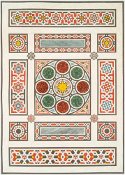From Picturesque Cairo to Abstract Islamic Designs: L’Art arabe and the Economy of Nineteenth-Century Book Publishing
by Paulina Banas

This article focuses on the production of L’Art arabe d’après les monuments du Caire depuis le 7ème siècle jusqu’à la fin du 18ème siècle (1869–77), a multi-volume illustrated album on the architecture and ornament of Islamic Cairo attributed to the French Egyptologist Émile Prisse d’Avennes. By examining the working relationships between Prisse d’Avennes, the French daguerreotypist Joseph-Philibert Girault de Prangey, the publisher Morel, the sponsor Savoy, and the printmakers involved in the preparation of Prisse d’Avennes’s plates, this study points out the conflicting views underlying the conceptualization of L’Art arabe, which was by no means singular in its conception or execution. It also demonstrates that the material included in L’Art arabe, which presents the changing fashions of the time from contextualized scenes of Cairo to abstract representations of Islamic designs, largely depended on the commercial prerogatives of the book’s sponsor and the publisher, rather than primarily upon Prisse d’Avennes’s own objectives.